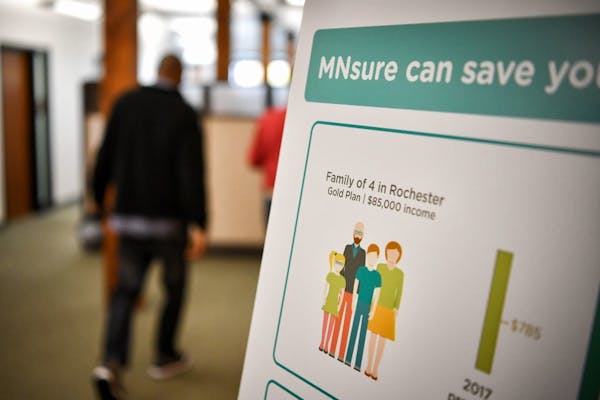MNsure saw the busiest day of the current open-enrollment period as its first sign-up deadline came Wednesday, pushing the tally of health insurance enrollees for next year to more than 108,000. .
The MNsure exchange is now 12.5 percent ahead of the 96,540 sign-ups last year at this time, state officials said Thursday. They expect to top the tally of nearly 115,000 people selecting individual health plans during the full enrollment period last year, even though there aren't as many weeks in the remainder of this season's open-enrollment calendar.
The sign-up numbers make MNsure officials confident they will meet or exceed their budget goal of roughly 4 percent growth next year in paying customers, said spokesman Jeremy Drucker.
"So far traffic and enrollment have been strong," Drucker said in an e-mail. "We're going to continue to monitor, but so far signs are good."
Minnesota launched the MNsure exchange in 2014 to implement the federal Affordable Care Act (ACA), which brought sweeping change to coverage for those under age 65 who are self-employed or don't get health insurance from an employer.
About 166,000 Minnesotans are buying individual health plans this year. Just over half do so through MNsure, while the remainder buy directly from health insurers.
While the MNsure portion of the market appears to be growing slightly for 2018, it's unclear what's happening to enrollment in the "off-exchange" market. Open enrollment has ended for people who want to buy directly from Eagan-based Blue Cross and Blue Shield of Minnesota, but the insurer doesn't yet have final numbers to compare with last year, said spokesman Jim McManus.
"The overall trend we've seen throughout the year is a slowdown of enrollment of off-exchange compared to 2016," McManus said in a statement. "This was expected, since more people who purchase on their own are going to MNsure to see if they qualify for subsidies in order to find the most affordable premiums."
Blue Cross plans are still available via MNsure, which also offers coverage from Bloomington-based HealthPartners, Minnetonka-based Medica and Minneapolis-based UCare.
Overall, the individual market in Minnesota is much smaller than it used to be — roughly 300,000 people in the state were buying individual coverage in 2014.
MNsure is an online marketplace where private insurers sell coverage, and Wednesday was the deadline for people to buy health plans that take effect Jan. 1. On deadline day, MNsure saw 2,342 net enrollments, Drucker said. Those who buy between now and the close of open enrollment on Jan. 14 will have coverage starting in February.
MNsure officials are optimistic about increasing the total number of sign-ups even though this year's open-enrollment period is about three and a half weeks shorter than it was a year ago. The optimism about modest growth has contrasted with the national outlook, where analysts projected fewer sign-ups.
On Thursday, the Centers for Medicare and Medicaid Services said more than 8.8 million people have signed up in the 39 states served by the federal HealthCare.gov website. That compares to 9.2 million last year in the same states — or 96 percent of the previous total.
The individual market in Minnesota has been very volatile since ACA changes kicked in, including big premium jumps and a significant decline in health plan choices. Premiums are relatively stable for 2018 due in part to a "reinsurance" program that's being funded next year with $271 million in state money.
While sign-up tallies grab headlines during open enrollment, what matters in terms of the MNsure budget and financing for the broader health care system is how many people actually end up buying coverage.
This "effectuated enrollment" count tends to be lower than the open-enrollment tally, because some people don't pay the first month's premium while others drop out as they find other coverage or opt to go without. At the same time, some are allowed to enter the market during the year under special circumstances.
This year, effectuated enrollment at MNsure has ranged from a March peak of roughly 94,000 down to 87,491 in October. Next year, the exchange's budget assumes an early peak of 97,424 with year-end effectuated enrollment at 91,224 — a growth rate of roughly 4 percent.
Christopher Snowbeck • 612-673-4744 Twitter: @chrissnowbeck
